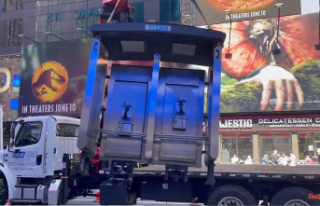The Elizabeth Line subway line opens its doors for the first passengers. The prestige project, which started late and is significantly more expensive, will significantly shorten the distances for many people in the London area. The remaining subway lines, on the other hand, are in rather poor condition.
The famous London Underground has a new queen. With the new route Elizabeth Line of the "Tube", as the subway is called in London, the British capital is getting its long-awaited east-west axis - just in time for the 70th anniversary of the throne of the namesake Queen Elizabeth II.
At 6.33 a.m. local time, the first Elizabeth Line train left Paddington station in London with several hundred anxious passengers. A number of transport fans had already stayed at the station during the night to be there. Waiting in line for hours at a closed train station is the most British thing imaginable, a passenger told the BBC this morning. "I'm excited. I'm like the little boy just before Christmas," admits London Mayor Sadiq Khan. The line, which should be completely passable in spring 2023, has already received royal honors. Dressed in bright yellow, Her Majesty has personally declared the Elizabeth Line open. The Queen looked like a phoenix with tremendous energy, project manager Mark Wild enthuses.
It is a construction of superlatives, with 10 new stations and 42 tunnels. The connection shines in royal purple on the subway map. But the construction time and costs are also record-breaking. The opening of the throne jubilee is more of a coincidence. The connection was actually supposed to start at the end of 2018, but in the end it took 13 years, three and a half more than planned. It was a digitally complex project, explains Wild. Costs shot up from £14.8bn to £19bn (about €22.5bn) also because of the delay.
Those responsible are sure that the investment is worthwhile. With the Elizabeth Line, 1.5 million people moved to the city within a 45-minute radius, emphasizes Wild. The new, ultra-long trains shoot through the tubes at almost 100 kilometers per hour, halving travel times between important hubs such as Paddington station and the financial center of Canary Wharf. Those responsible cheer about a "game changer", i.e. a groundbreaking change. Once fully operational, the link will extend 113 kilometers - from Reading in Berkshire in the west, with a branch to major Heathrow Airport, to Shenfield in Essex in the east. The connection time between Stansted and Heathrow airports, for example, should then be significantly shorter.
But functionality alone is not enough. With the Elizabeth Line, London wants to catapult its aging subway network to the top of the world. Project manager Wild does not stop raving, he speaks of "cathedral-like stations", "acoustically and climatically perfect". The new building is the "pride of the UK", offers "the best of British engineering" and is simply the "achievement of the century". But it's not just the hymns of praise that put pressure on designers and tube managers to ensure that nothing can go wrong.
The modern tube with spacious stations and modern interior throws a spotlight on how dilapidated the London underground actually is. Scoffers say little has changed since the first connection opened in 1863. Critics complain about narrow and stuffy carriages, traffic regularly has to be stopped due to signal errors or flooding. With up to five million passengers a day, the tube is the heartbeat of the city. If things don't go on, London stands still.
There is no money for renovations, the pandemic has torn a huge hole. Mayor Sadiq Khan has repeatedly argued with the central government about funding. Possible sources of income are higher tolls for drivers in the city and a larger environmental zone. Savings could also be made on the bus network. Because they are doubling with the Elizabeth Line, Khan plans to move several bus routes out of the city to the suburbs.












